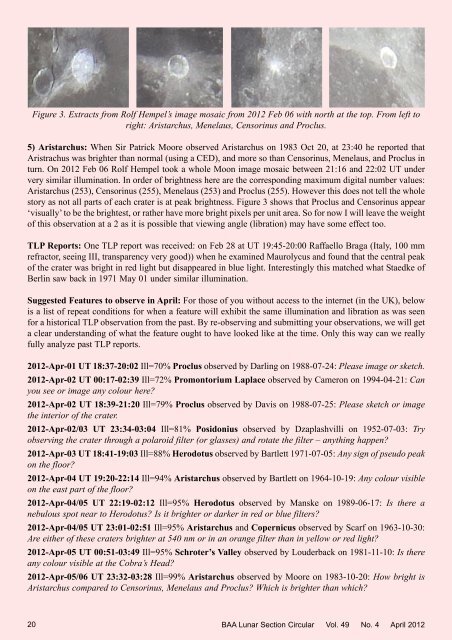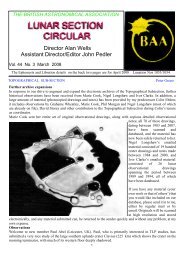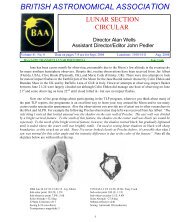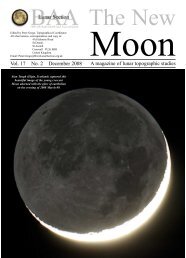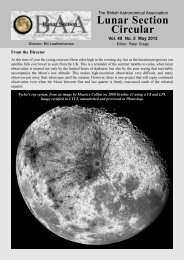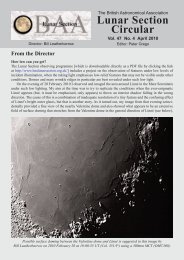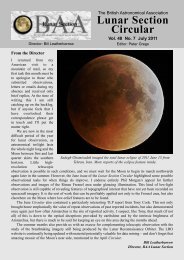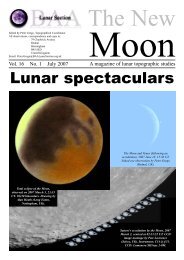Vol 49, No 4, April 2012 - BAA Lunar Section
Vol 49, No 4, April 2012 - BAA Lunar Section
Vol 49, No 4, April 2012 - BAA Lunar Section
Create successful ePaper yourself
Turn your PDF publications into a flip-book with our unique Google optimized e-Paper software.
Figure 3. Extracts from Rolf Hempel’s image mosaic from <strong>2012</strong> Feb 06 with north at the top. From left to<br />
right: Aristarchus, Menelaus, Censorinus and Proclus.<br />
5) Aristarchus: When Sir Patrick Moore observed Aristarchus on 1983 Oct 20, at 23:40 he reported that<br />
Aristrachus was brighter than normal (using a CED), and more so than Censorinus, Menelaus, and Proclus in<br />
turn. On <strong>2012</strong> Feb 06 Rolf Hempel took a whole Moon image mosaic between 21:16 and 22:02 UT under<br />
very similar illumination. In order of brightness here are the corresponding maximum digital number values:<br />
Aristarchus (253), Censorinus (255), Menelaus (253) and Proclus (255). However this does not tell the whole<br />
story as not all parts of each crater is at peak brightness. Figure 3 shows that Proclus and Censorinus appear<br />
‘visually’ to be the brightest, or rather have more bright pixels per unit area. So for now I will leave the weight<br />
of this observation at a 2 as it is possible that viewing angle (libration) may have some effect too.<br />
TLP Reports: One TLP report was received: on Feb 28 at UT 19:45-20:00 Raffaello Braga (Italy, 100 mm<br />
refractor, seeing III, transparency very good)) when he examined Maurolycus and found that the central peak<br />
of the crater was bright in red light but disappeared in blue light. Interestingly this matched what Staedke of<br />
Berlin saw back in 1971 May 01 under similar illumination.<br />
Suggested Features to observe in <strong>April</strong>: For those of you without access to the internet (in the UK), below<br />
is a list of repeat conditions for when a feature will exhibit the same illumination and libration as was seen<br />
for a historical TLP observation from the past. By re-observing and submitting your observations, we will get<br />
a clear understanding of what the feature ought to have looked like at the time. Only this way can we really<br />
fully analyze past TLP reports.<br />
<strong>2012</strong>-Apr-01 UT 18:37-20:02 Ill=70% Proclus observed by Darling on 1988-07-24: Please image or sketch.<br />
<strong>2012</strong>-Apr-02 UT 00:17-02:39 Ill=72% Promontorium Laplace observed by Cameron on 1994-04-21: Can<br />
you see or image any colour here<br />
<strong>2012</strong>-Apr-02 UT 18:39-21:20 Ill=79% Proclus observed by Davis on 1988-07-25: Please sketch or image<br />
the interior of the crater.<br />
<strong>2012</strong>-Apr-02/03 UT 23:34-03:04 Ill=81% Posidonius observed by Dzaplashvilli on 1952-07-03: Try<br />
observing the crater through a polaroid filter (or glasses) and rotate the filter – anything happen<br />
<strong>2012</strong>-Apr-03 UT 18:41-19:03 Ill=88% Herodotus observed by Bartlett 1971-07-05: Any sign of pseudo peak<br />
on the floor<br />
<strong>2012</strong>-Apr-04 UT 19:20-22:14 Ill=94% Aristarchus observed by Bartlett on 1964-10-19: Any colour visible<br />
on the east part of the floor<br />
<strong>2012</strong>-Apr-04/05 UT 22:19-02:12 Ill=95% Herodotus observed by Manske on 1989-06-17: Is there a<br />
nebulous spot near to Herodotus Is it brighter or darker in red or blue filters<br />
<strong>2012</strong>-Apr-04/05 UT 23:01-02:51 Ill=95% Aristarchus and Copernicus observed by Scarf on 1963-10-30:<br />
Are either of these craters brighter at 540 nm or in an orange filter than in yellow or red light<br />
<strong>2012</strong>-Apr-05 UT 00:51-03:<strong>49</strong> Ill=95% Schroter’s Valley observed by Louderback on 1981-11-10: Is there<br />
any colour visible at the Cobra’s Head<br />
<strong>2012</strong>-Apr-05/06 UT 23:32-03:28 Ill=99% Aristarchus observed by Moore on 1983-10-20: How bright is<br />
Aristarchus compared to Censorinus, Menelaus and Proclus Which is brighter than which<br />
20<br />
<strong>BAA</strong> <strong>Lunar</strong> <strong>Section</strong> Circular <strong>Vol</strong>. <strong>49</strong> <strong>No</strong>. 4 <strong>April</strong> <strong>2012</strong>


